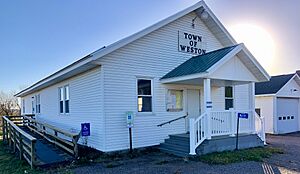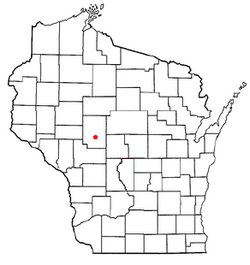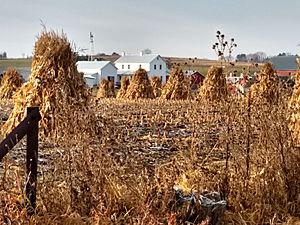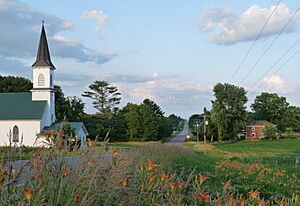Weston, Clark County, Wisconsin facts for kids
Quick facts for kids
Weston, Wisconsin
|
|
|---|---|

Town hall
|
|

Location of Weston, Wisconsin
|
|
| Country | |
| State | |
| County | Clark |
| Area | |
| • Total | 36.3 sq mi (94.0 km2) |
| • Land | 36.1 sq mi (93.6 km2) |
| • Water | 0.1 sq mi (0.3 km2) |
| Elevation | 1,096 ft (334 m) |
| Population
(2000)
|
|
| • Total | 638 |
| • Density | 17.7/sq mi (6.8/km2) |
| Time zone | UTC-6 (Central (CST)) |
| • Summer (DST) | UTC-5 (CDT) |
| Area code(s) | 715 & 534 |
| FIPS code | 55-85925 |
| GNIS feature ID | 1584411 |
| PLSS township | T25N R2W |
Weston is a small town in Clark County, located in the U.S. state of Wisconsin. In the year 2000, about 638 people lived there. Two smaller communities, Christie and Globe, are also part of the town of Weston.
Contents
What is Weston Like?
Weston covers an area of about 36.3 square miles (94.0 square kilometers). Most of this area is land, about 36.1 square miles (93.6 square kilometers). A very small part, 0.1 square miles (0.3 square kilometers), is water.

How Did Weston Begin?
Early Surveys and Settlements
The area that is now Weston was first mapped in June 1847 by people working for the U.S. government. They walked through forests and swamps to measure the land. Their maps showed an early road, an "Indian Camp," and a cabin.
The surveyors described the land as good for farming. They noted that the central and southwestern parts had lots of trees like sugar maple and oak. The southeastern part had many white pine trees. They also mentioned Perry's Creek and the Black River, which had places for sawmills.
Growing Roads and Communities
By 1873, a "highway" connected Neillsville to Weston and beyond. This was a dirt road for wagons. Another wagon road went east from this main road. At that time, Weston was much larger than it is today.
By 1880, more wagon roads were built. About 30 settler homes were along these roads. The Christie Post Office was open, and there were rural schools. A sawmill and a "Hotel" also existed. West of the Black River, there were fewer roads and settlers. Much of the land was owned by lumber companies.
Stagecoaches and New Developments
By 1890, a stagecoach traveled through Weston every day. It followed the dirt road that is now Highway 73. This helped people travel and connect with other towns.
By 1893, even more roads and homes appeared. A new school was built near Christie Mound. The communities of Globe also grew, with a new mill, church, and cemetery. Large areas of land were still owned by lumber companies.
Weston in the Early 1900s
By 1906, Weston had its current size. More roads were added, and many more settlers moved in. A new sawmill was built where County G meets Fremont Road today.
Christie was an important community on Highway 73. In 1918, it had a store, two churches, and a school. It was a key post office for the area.
Globe was another small community a few miles west of Christie. It served local farmers. In 1918, Globe had a creamery (where butter and cheese are made), a large German Lutheran Church and school, and a store.
By 1920, most of Weston was settled, even west of the river. A cheese factory was built, showing that farming was becoming very important. The area was changing from logging to agriculture.
Who Lives in Weston?
In 2000, Weston had 638 people living in 230 households. Most people were White. About 35% of households had children under 18. Most households were married couples living together.
The population included people of all ages. About 27% were under 18, and 13% were 65 or older. The average age was 38 years old.
Most families in Weston had a good income. The average income for a family was about $45,833 per year.
See also
 In Spanish: Weston (condado de Clark, Wisconsin) para niños
In Spanish: Weston (condado de Clark, Wisconsin) para niños


